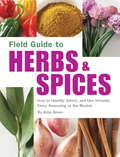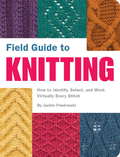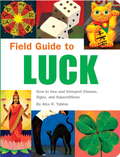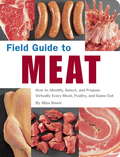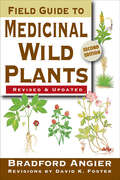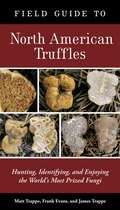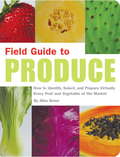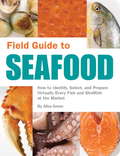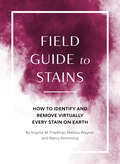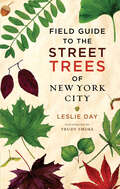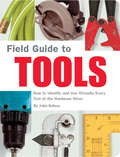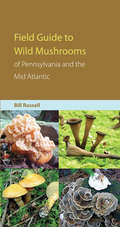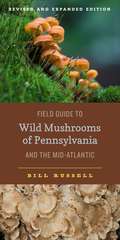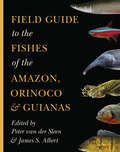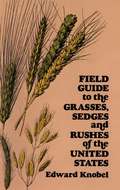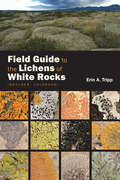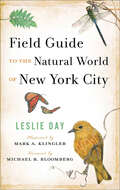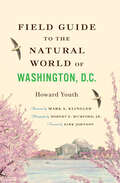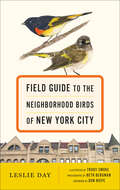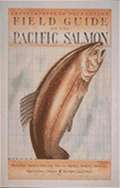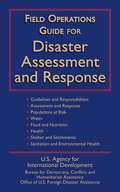- Table View
- List View
Field Guide to Herbs and Spices
by Aliza GreenField Guide to Herbs & Spices will forever change the way you cook. With this practical guide--including full-color photographs of more than 200 different herbs, spices, and spice mixtures--you'll never again be intimidated or confused by the vast array of spices available. Learn to discern the differences between the varieties of basil, the various colors of sesame seeds, the diverse types of sugar and salt, and even how to identify spice pastes like zhoug, harissa, and achiote. Each entry features a basic history of the herb or spice (saffron used to be worth more than gold!), its season (if applicable), selection and preparation tips, a recipe featuring the seasoning, and some suggested flavor pairings. Complete with more than one hundred recipes, Field Guide to Herbs & Spices is a must-have resource for every home cook. Meals will never be the same again!
Field Guide to Knitting
by Jackie PawlowskiAt last, a field guide to identifying and working more than 200 knitting stitches, from stockinette to Orenburg lace! There are so many intriguing ways to knit yarn that it's often tough to pick the right stitch. Help is on the way with Field Guide to Knitting, the stitch dictionary that belongs in every knitting bag. This handy go-to reference book takes a comprehensive look at knit and purl stitches as well as cables, laces, ribs, and edge treatments. Learn to tell k2togs from ssks and to differentiate between ribbed basketweave and basket cable. Each entry reveals the history of the stitch, the best stitch gauge for achieving pattern definition, the garments most suited to the pattern, and more. Complete patterns for executing the stitch (and its variations) are also included. More than 200 full-color photographs make it easy to compare how stitches will look before committing yarn to needles. Whether you just need to know if moss stitch is the same as seed stitch or you're planning a complicated Aran sweater, Field Guide to Knitting has all the answers.
Field Guide to Luck
by Alys R. YablonTake Control of Your Destiny! From the good luck provided by shamrocks, rabbits's feet, and horseshoes to the misfortune caused by broken mirrors, black cats, and umbrellas opened indoors, our lives are filled with signs and superstitions that guide our destiny and influence our fate. Fortunately, Field Guide to Luck can help you recognize dozens of influential charms, dates, sayings, and symbols wherever you encounter them. Learn what objects are on your side, which practices are best avoided, and where these curious beliefs come from. This indispensable guide reveals their fascinating origins and offers tips for putting them into practice. With Lady Luck on your side and a lucky penny in your pocket, you're sure to lead a charmed life!
Field Guide to Meat
by Aliza GreenAt last, a field guide to identifying and selecting more than 200 different cuts and kinds of meat, from beef and poultry to game and cured meat! An essential resource for every home cook or chef, Field Guide to Meat offers details on virtually every kind of meat available. This practical guide includes more than 200 full-color photographs of cuts of beef, veal, pork, lamb, game, and poultry as well as more than 100 different kinds of cured meats and sausages. Cross-referenced with the photographs are in-depth descriptions of the cuts, including basic history, location in the animal, characteristics, information on how to choose the cut, and flavor affinities. Step-by-step preparation directions tell you whether the item is best marinated, braised, grilled, roasted, or pan-seared. Trips to the butcher's aisle will no longer be intimidating, and you'll never end up with a cut that's too tough for dinner.
Field Guide to Medicinal Wild Plants
by Bradford AngierA revision of the definitive reference, containing plant characteristics, distribution, and medicinal qualities, an updated taxonomy, and fifteen new species. The Field Guide to Medicinal Wild Plants is the ultimate handbook for identifying and using wild plants for medicinal purposes. This illustrated guide to North American wild medicinals has been a nature classic for over thirty years. In this second edition, David K. Foster revises Bradford Angier's invaluable reference, updating the taxonomy and adding more than a dozen species, including the purple coneflower, popularly known as echinacea, as well as ephedra, jewelweed, goldenseal, and more. Scientific information for a general audience and full-color illustrations combine with intriguing accounts of the plants&’ uses, making this a practical guide for anyone interested in the medicinal uses of wild plants.
Field Guide to North American Truffles: Hunting, Identifying, and Enjoying the World's Most Prized Fungi
by James M. Trappe Frank Evans Matt TrappeThe second most expensive food in the world after saffron, truffles are treasured, coveted, and savored for their mysterious and exotic flavor. This complete field guide shows chefs and fungi aficionados how to forage for and identify the wide variety of truffles that grow in temperate forests throughout North America. Written by expert horticulturalists who have studied, classified, and enjoyed truffles for decades, the FIELD GUIDE TO NORTH AMERICAN TRUFFLES makes these celebrated underground jewels accessible to all. The first full-color illustrated guide to identifying North American truffles by their key features, including profiles of more than 80 species of truffles. Includes more than 80 photographs of rare and hard-to-find truffle species. Features flavor profiles, delectability index, and culinary tips for each species. Perfect size for carrying in a pocket or daypack.Reviews"It'¬?s the first book of its kind, complete with photographs, cross-sectional views of indigenous truffle varieties, guides to seasonal availability, and foraging tips for hundreds of kinds of truffles (both the edible and inedible kinds), as well as tasting notes and cooking tips."-SaveurFrom the Trade Paperback edition.
Field Guide to Produce
by Aliza GreenAt last, a field guide to identifying and selecting more than 200 fruits and vegetables from around the world! The perfect companion for every shopper, Field Guide to Produce offers tips for selecting, storing, and preparing everything from apples to zucchini. When an unfamiliar edible appears on your grocer's shelf, simply flip through the full-color insert until you've found its photograph. Turn to the corresponding page to discover its country of origin, common uses, and season of harvest. This practical guide includes more than 200 full-color photographs of the world's most popular fruits and vegetables, cross-referenced to in-depth descriptions and selection tips. Step-by-step preparation directions tell you whether the item must be peeled, washed, trimmed, or blanched. Grocery shopping--and dinner--will never be the same again!
Field Guide to Seafood
by Aliza GreenAt last, a field guide to identifying and selecting seafood from around the world, including barramundi, lobsterette, wahoo, and more! With the daunting array of fish and shellfish available in today's market, Field Guide to Seafood is a must-have for every seafood consumer! This helpful guide offers a comprehensive look at seafood, covering more than 100 different kinds of fish and shellfish, plus preserved fish, fish sauces, and caviar. Learn to differentiate between Arctic char and salmon or between snow crabs and stone crabs with the in-depth descriptions and full-color photographs. Each entry contains a list of alternate names, characteristics, and suggested preparation, including directions on when to remove or leave the skin. Step-by-step instructions explain how to identify, store, and cook the item. Whether your fish is store-bough or just caught, this guide includes selection tips, suggested recipes, and complementary flavors. You'll never feel overwhelmed by the wide variety of seafood with this handy guide -- don't go shopping without it!
Field Guide to Stains: How to Identify and Remove Virtually Every Stain on Earth (Field Guide)
by Nancy Armstrong Melissa Wagner Virginia M. FriedmanAt last, a field guide to identifying and doing battle with more than 100 stains, from tomato juice to tar, from avocado to urine! Field Guide to Stains is divided into handy sections for easy access to information when time is of the essence: Fruits and Vegetables, Meat and Protein, Household Items, Garage and Yard, and more. Readers will learn more than just removal techniques--details include general descriptions and likely seasons, times, and areas of occurrence. Did you know that a yogurt stain is more likely to occur in January (when New Year's resolutions demand more healthy eating), and that correction fluid stains are more prevalent in April (when the pressure to complete your taxes on time is at a high)? Includes more than 100 full-color photographs of stains, each one cross-referenced to its description and step-by-step removal advice. Quick-reference icons guide the reader to the most essential information in each entry. This guide has a sturdy, stain-proof exterior--making it a necessity for every cubicle, glove compartment, and college dorm. Field Guide to Stains is a must-have for everyone about to venture out into the wild, to the kitchen, or to a night on the town!
Field Guide to Street Trees New York City
by Leslie Day“A handbook for naturalists, sidewalk denizens, apartment dwellers, dog-walkers, and bicycle riders . . . No New Yorker should be without this book.” —Wayne Cahilly, New York Botanical GardenNew York City is an urban oasis with hundreds of thousands of trees, and this guide acquaints residents and visitors alike with fifty species commonly found in the neighborhoods where people live, work, and travel. Beautiful, original drawings of leaves and stunning photographs of bark, fruit, flower, and twig accompany informative descriptions of each species. Detailed maps of the five boroughs identify all of the city’s neighborhoods, and specific addresses pinpoint where to find a good example of each tree species.Trees provide invaluable benefits to the Big Apple: they reduce the rate of respiratory disease, increase property values, cool homes and sidewalks in the summer, block the harsh winds of winter, clean the air, absorb storm water runoff, and provide habitat and food for the city’s wildlife. Bald cypress, swamp oak, silver linden, and all of New York’s most common trees are just a page turn away. Your evening walk will never be the same once you come to know the quiet giants that line the city’s streets.
Field Guide to Tools
by John KelseyFinally, a field guide to identifying and utilizing more than 100 tools, from an awl to a propane torch, from a table saw to a screwdriver! Field Guide to Tools is the ultimate guide to all the gear any handyperson requires. Hardware stores, home stores, and garden stores are full of unrecognizable items--here's how you can find out what tool is appropriate for your job and just how to go about employing it. Descriptive pages outline the basic history and use for each tool, inventive alternate functions, and operating principles; component parts are illustrated by helpful diagrams; and more than 100 full-color photographs aid in identification while at the hardware store. Step-by-step directions walk you through the basics of using each tool properly and safely. Don't attempt another at-home fix-it project without Field Guide to Tools!
Field Guide to Wild Mushrooms of Pennsylvania and the Mid-Atlantic (Keystone Books)
by Bill RussellTo most Americans, mushrooms are the brown lumps in the soup one uses to make a tuna casserole, but to a select few, mushrooms are the abundant yet often well-hidden delicacies of the forests. In spite of their rather dismal reputation, most wild mushrooms are both edible and delicious, when prepared properly. From the morel to the chanterelle and the prolific and aptly named chicken of the woods, mushrooms can easily be harvested and enjoyed, if you know where to look and what to look for. Bill Russell’s Field Guide to the Wild Mushrooms of Pennsylvania and the Mid-Atlantic helps the reader learn just that—specifically for the often-neglected East Coast mushrooms of the United States and Canada.Suited to both the novice and the experienced mushroom hunter, this book helps the reader identify mushrooms with the use of illustrations, descriptions, and environmental observations. Russell’s fifty years of experience in hunting, studying, and teaching about wild mushrooms have been carefully distilled into this easy-to-use and well-designed guide. The book is divided into the four seasons, each with its unique mushroom offerings. Each mushroom section includes a detailed description, information about the mushroom’s biology, tips on where the mushroom is most likely to be found, and a short “nutshell” description for quick reference. The book also includes color photographs of each of the mushrooms described.Russell’s Field Guide to the Wild Mushrooms of Pennsylvania and the Mid-Atlantic shows the reader not only how to identify the most common mushrooms found in the region but also how to avoid common copycats—and what to do with the mushrooms once they’re identified and harvested. With both color illustrations and insightful descriptions of one hundred of the area’s most common mushrooms, Field Guide is an indispensable reference for the curious hiker, the amateur biologist, or the adventurous chef.
Field Guide to Wild Mushrooms of Pennsylvania and the Mid-Atlantic: Revised and Expanded Edition (Keystone Books)
by Bill RussellThis revised and expanded edition of mushroom expert Bill Russell’s popular Field Guide to Wild Mushrooms of Pennsylvania and the Mid-Atlantic provides both novice and experienced mushroom foragers with detailed, easy-to-use information about more than one hundred species of these fungi, including twenty-five varieties not found in the previous guide.From the Morel to the Chanterelle to the aptly named Chicken of the Woods, mushrooms of the mid-Atlantic region can be harvested and enjoyed, if you know where to look. Each entry in this field guide contains a detailed description, current scientific classification, key updates and information from recent studies, and high-quality color photographs to aid in identification. Thoughtfully organized by season, the guide shows you how to locate and identify the most common mushrooms in the region and recognize look-alikes—and explains what to do with edible mushrooms once you’ve found them.Featuring over one hundred full-color illustrations and distilling Russell’s fifty years of experience in hunting, studying, and teaching about wild mushrooms, Field Guide to Wild Mushrooms of Pennsylvania and the Mid-Atlantic is an indispensable reference for curious hikers, amateur biologists, adventurous chefs, and mycophiles of all stripes.
Field Guide to Wild Mushrooms of Pennsylvania and the Mid-Atlantic: Revised and Expanded Edition (Keystone Books)
by Bill RussellThis revised and expanded edition of mushroom expert Bill Russell’s popular Field Guide to Wild Mushrooms of Pennsylvania and the Mid-Atlantic provides both novice and experienced mushroom foragers with detailed, easy-to-use information about more than one hundred species of these fungi, including twenty-five varieties not found in the previous guide.From the Morel to the Chanterelle to the aptly named Chicken of the Woods, mushrooms of the mid-Atlantic region can be harvested and enjoyed, if you know where to look. Each entry in this field guide contains a detailed description, current scientific classification, key updates and information from recent studies, and high-quality color photographs to aid in identification. Thoughtfully organized by season, the guide shows you how to locate and identify the most common mushrooms in the region and recognize look-alikes—and explains what to do with edible mushrooms once you’ve found them.Featuring over one hundred full-color illustrations and distilling Russell’s fifty years of experience in hunting, studying, and teaching about wild mushrooms, Field Guide to Wild Mushrooms of Pennsylvania and the Mid-Atlantic is an indispensable reference for curious hikers, amateur biologists, adventurous chefs, and mycophiles of all stripes.
Field Guide to the Fishes of the Amazon, Orinoco, and Guianas
by James S. Albert Peter van der SleenThe Amazon and Orinoco basins in northern South America are home to the highest concentration of freshwater fish species on earth, with more than 3,000 species allotted to 564 genera. Amazonian fishes include piranhas, electric eels, freshwater stingrays, a myriad of beautiful small-bodied tetras and catfishes, and the largest scaled freshwater fish in the world, the pirarucu. Field Guide to the Fishes of the Amazon, Orinoco, and Guianas provides descriptions and identification keys for all the known genera of fishes that inhabit Greater Amazonia, a vast and still mostly remote region of tropical rainforests, seasonally flooded savannas, and meandering lowland rivers.The guide’s contributors include more than fifty expert scientists. They summarize the current state of knowledge on the taxonomy, species richness, and ecology of these fish groups, and provide references to relevant literature for species-level identifications. This richly illustrated guide contains 700 detailed drawings, 190 color photos, and 500 distribution maps, which cover all genera. An extensive and illustrated glossary helps readers with the identification keys.The first complete overview of the fish diversity in the Amazon, Orinoco, and Guianas, this comprehensive guide is essential for anyone interested in the freshwater life inhabiting this part of the world.First complete overview of the fish diversity in the Amazon and Orinoco basinsContributors include more than fifty expertsIdentification keys and distribution maps for all genera190 stunning color photos 700 detailed line drawingsExtensive and illustrated glossary
Field Guide to the Grasses, Sedges, and Rushes of the United States
by Edward KnobelWith its clear, easy-to-use format, accurate line drawings, and concise descriptions, Edward Knobel's Field Guide can help make you an expert at identifying the common grasses, sedges, and rushes of the United States. Over 370 of the most common species are accurately described in this handy volume: varieties of timothy, rye, foxtail, fescue, bluegrass, nutrush, cottongrass, bulrush, etc. Knobel's emphasis is upon wild varieties of these plants common to the eastern and central United States, but many cultivated strains and food grains such as rice, oats, and maize are also included.A general key on the first page of this book allows you to fit each plant into one of several basic structural categories. Further subdivisions, classified according to the structure of the ear and spikelet (the flowering part of the plant) identify the particular species. Each plant is then described according to common name, Latin name, height, color of flower and stem, texture, smell (if applicable), habitat, and even edibility. Close resemblances to other varieties are also noted, which helps to make identifications even easier. Each description is also accompanied by a drawing of an entire plant, and a second drawing of the actual spikelet (with scale of the drawing noted). The author includes a total of 28 plates and over 600 line drawings.This new Dover edition has been completely revised, with common and scientific nomenclature updated, by Mildred E. Faust, Professor of Botany, Emeritus, Syracuse University.
Field Guide to the Lichens of White Rocks: (Boulder, Colorado)
by Erin TrippField Guide to the Lichens of White Rocks is a careful examination of the lichens that occur at the ecologically important and lichenologically rich urban outcropping of Fox Hills sandstone known as White Rocks Nature Preserve, located in Boulder County, Colorado. This extensively illustrated field guide presents detailed information on the macroscopic and microscopic features needed to identify species, as well as extensive notes on how to differentiate closely related lichens—both those present at White Rocks and those likely to be found elsewhere in western North America. This guide is one of the only complete lichen inventories of a sandstone formation in North America and covers all constituents including the crustose microlichen biota, traditionally excluded from other inventories. A short introduction and glossary equip the reader with basic information on lichen morphology, reproduction, and ecology. Visitors to White Rocks Nature Preserve must schedule staff-led public tours or set up sponsored research projects through the City of Boulder Open Space and Mountain Parks, and there are many other outcroppings of Fox Hills sandstone across the West, making Field Guide to the Lichens of White Rocks a significant resource for anyone interested in this unique environment. This accessible, user-friendly guide will also be valuable to naturalists and lichenologists around the world as well as educators, conservationists, and land managers concerned with the growing significance of open spaces and other protected urban areas throughout North America. The University Press of Colorado gratefully acknowledges the generous support of the University of Colorado Natural History Museum, City of Boulder Parks & Open Spaces, and the Colorado Native Plant Society board and members toward the publication of this book.
Field Guide to the Natural World of New York City
by Leslie Day"This little gem fills you in on everything finned, furred, feathered, or leafed, and how to find it, in all five boroughs."—House and GardenSecond place for scholarly/reference books (design), Bookbinders' Guild of New York 2008 New York Book Show.New York just might be the most biologically diverse city in temperate America. The five boroughs sit atop one of the most naturally rich sites in North America, directly under the Atlantic migratory flyway, at the mouth of a 300-mile-long river, and on three islands—Manhattan, Staten, and Long. Leslie Day, a New York City naturalist, reveals this amazing world in her Field Guide to the Natural World of New York City. Combining the stunning paintings of Mark A. Klingler with a variety of photographs and maps, this book is a complete guide for the urban naturalist—with tips on identifying the city's flora and fauna and maps showing the nearest subway stop.Here is your personal guide to the real wild side of America’s largest city. Throw it in your backpack, hop on the subway, and explore.
Field Guide to the Natural World of New York City
by Leslie Day“This little gem fills you in on everything finned, furred, feathered, or leafed, and how to find it, in all five boroughs” (House and Garden).New York just might be the most biologically diverse city in temperate America. The five boroughs sit atop one of the most naturally rich sites in North America, directly under the Atlantic migratory flyway, at the mouth of a 300-mile-long river, and on three islands?Manhattan, Staten, and Long.Leslie Day, a New York City naturalist, reveals this amazing world in her Field Guide to the Natural World of New York City. Combining the stunning paintings of Mark A. Klingler with a variety of photographs and maps, this book is a complete guide for the urban naturalist?with tips on identifying the city's flora and fauna and maps showing the nearest subway stop.Here is your personal guide to the real wild side of America’s largest city. Throw it in your backpack, hop on the subway, and explore.“Dr. Day . . . A sort of Julia Child of nature.” —Ellen Pall, New York Times“Provides historic facts, photographs and maps to give a snapshot of the city’s natural resources and to remind hard-charging New Yorkers of the unchanging parts of their environment.” —Sally Goldenberg, Staten Island Advance“This book should be in every New Yorker’s library as both reference and inspiration for low-carbon-impact journeys to places of unexpected beauty and tranquility.” —Crawford-Doyle Booksellers Newsletter“You may well wonder why I am reviewing a book about New York city when we preach 'local, local, local' throughout these pages. I'll tell you, because this beautifully illustrated handbook is a wonderful example of exploring the bucolic city. . . . All illustrated with gorgeous watercolors by Klingler. We should have one of these. But in the meantime, you will find many of the same species in our fair cities., so why not pick up a copy for inspiration?”—Minneapolis Observer Quarterly
Field Guide to the Natural World of Washington, D.C.
by Howard YouthA field guide to plants and animals commonly found in the nation's capital.Winner of the Design and Effectiveness Award of the Washington PublishersNature awaits discovery at almost every turn in the complex ecosystem of Washington, D.C. In parks large and small, within the District's gardens, and on public streets, there is tremendous biodiversity. In Field Guide to the Natural World of Washington, D.C., naturalist Howard Youth takes us on an urban safari, describing the wild side of the nation's capital.Beyond the abundant wildlife that can be seen in every neighborhood, Washington boasts a large park network rich in natural wonders. A hike along the trails of Rock Creek Park, one of the country’s largest and oldest urban forests, quickly reveals white-tailed deer, eastern gray squirrels, and little brown bats. Mayapples, Virginia bluebells, and red mulberry trees are but a few of the treasures found growing at the National Arboretum. A stroll along the Potomac and Anacostia Rivers might reveal stealthy denizens such as bullfrogs, largemouth bass, and common snapping turtles. Detailed drawings by Carnegie artist Mark A. Klingler and photography by Robert E. Mumford, Jr., reveal the rich color and stunning beauty of the flora and fauna awaiting every D.C. naturalist.Whether seeking a secluded jog or an adventurous outing, residents and tourists alike will find this handsome guide indispensable for finding oases away from the noise of the city.
Field Guide to the Neighborhood Birds of New York City
by Leslie Day Don RiepeNew York City's favorite naturalist is back with a guided tour of the Big Apple that unveils the beautiful birds living in its midst.Winner of the Hardcover Nonfiction (Design) of The New York Book Show, Illustrated Text of the Washington PublishersLook around New York, and you’ll probably see birds: wood ducks swimming in Queens, a stalking black-crowned night-heron in Brooklyn, great horned owls perching in the Bronx, warblers feeding in Central Park, or Staten Island’s purple martins flying to and fro. You might spot hawks and falcons nesting on skyscrapers or robins belting out songs from trees along the street. America’s largest metropolis teems with birdlife in part because it sits within the great Atlantic flyway where migratory birds travel seasonally between north and south. The Big Apple’s miles of coastline, magnificent parks, and millions of trees attract dozens of migrating species every year and are also home year-round to scores of resident birds. There is no better way to identify and learn about New York’s birds than with this comprehensive field guide from New York City naturalist Leslie Day. Her book will quickly teach you what each species looks like, where they build their nests, what they eat, the sounds of their songs, what time of year they appear in the city, the shapes and colors of their eggs, and where in the five boroughs you can find them—which is often in the neighborhood you call home. The hundreds of stunning photographs by Beth Bergman and gorgeous illustrations by Trudy Smoke will help you identify the ninety avian species commonly seen in New York. Once you enter the world of the city’s birds, life in the great metropolis will never look the same.
Field Guide to the Neighborhood Birds of New York City
by Leslie DayNew York City’s favorite naturalist returns with a guided tour of the beautiful birds living in the five boroughs.Look around New York, and you’ll probably see birds: wood ducks swimming in Queens, a stalking black-crowned night-heron in Brooklyn, great horned owls perching in the Bronx, warblers feeding in Central Park, or Staten Island’s purple martins flying to and fro. You might spot hawks and falcons nesting on skyscrapers or robins belting out songs from trees along the street.America’s largest metropolis teems with birdlife in part because it sits within the great Atlantic flyway where migratory birds travel seasonally between north and south. The Big Apple’s miles of coastline, magnificent parks, and millions of trees attract dozens of migrating species every year and are also home year-round to scores of resident birds.There is no better way to identify and learn about New York’s birds than with this comprehensive field guide from New York City naturalist Leslie Day. Her book will quickly teach you what each species looks like, where they build their nests, what they eat, the sounds of their songs, what time of year they appear in the city, the shapes and colors of their eggs, and where in the five boroughs you can find them?which is often in the neighborhood you call home. The hundreds of stunning photographs by Beth Bergman and gorgeous illustrations by Trudy Smoke will help you identify the ninety avian species commonly seen in New York. Once you enter the world of the city’s birds, life in the great metropolis will never look the same.“‘Take this guide wherever you go,’ [Day] implores readers in the introduction. And we hope many do, since it reveals a New York we long to see, the wild, beautiful city of birds known to Audubon, Chapman, and Griscom.” —Chuck Hagner, BirdWatching Magazine“An excellent guide for New York City residents. If you have any interest in the birds around you (and there are plenty of birds around you, even in NYC), this guide will really open your eyes.” —Birder's Library“Day’s deeply researched and richly illustrated Field Guide to the Neighborhood Birds of New York City will be indispensable to locals and tourists alike.” —Sierra“Will fill a niche for beginning birders and backyard watchers in the northeastern U.S.” —Choice“You don’t have to live in or be visiting New York to enjoy this book.” —Times Literary Supplement (UK)
Field Guide to the Street Trees of New York City
by Leslie DayImagine an urban oasis with hundreds of thousands of trees and whose mayor wants to plant a million more. That sylvan place is New York City, and this is a guide to the diverse trees that line its streets.Field Guide to the Street Trees of New York City acquaints New Yorkers and visitors alike with fifty species of trees commonly found in the neighborhoods where people live, work, and travel. Beautiful, original drawings of leaves and stunning photographs of bark, fruit, flower, and twig accompany informative descriptions of each species. Detailed maps of the five boroughs identify all of the city’s neighborhoods, and specific addresses pinpoint where to find a good example of each tree species. Trees provide invaluable benefits to the Big Apple: they reduce the rate of respiratory disease, increase property values, cool homes and sidewalks in the summer, block the harsh winds of winter, clean the air, absorb storm water runoff, and provide habitat and food for the city’s wildlife.Bald cypress, swamp oak, silver linden, and all of New York’s most common trees are just a page turn away. Your evening walk will never be the same once you come to know the quiet giants that line the city's streets.
Field Operations Guide for Disaster Assessment and Response
by U.S. Agency for International DevelopmentIn developing this third revision of version 4.0 of the Field Operations Guide for Disaster Assessment and Response, the Office of U.S. Foreign Disaster Assistance (OFDA) of the United States Agency of International Development (USAID) has drawn on the expertise of numerous state, national, and international agencies and organizations. Selected sources of information include the United Nations High Commissioner for Refugees' Handbook for Emergencies, the United Nations Office for the Coordination of Humanitarian Affairs' United Nations Disaster Assessment and Coordination Field Handbook, and the U.S. Public Health Service's Handbook of Environmental Health, among others. The Field Operations Guide for Disaster Assessment and Response has been created as a reference tool for individuals sent to disaster sites to undertake initial assessments or to participate as members of a Disaster Assistance Response Team (DART). It contains information on general responsibilities for disaster responders, formats and reference material for assessing and reporting on populations at risk, DART position descriptions and duty checklists, descriptions of OFDA stockpile commodities, information for working with military in the field, and much more. Its myriad resources, extensive information, and handy compact format make this field guide a necessary companion for those participating in a variety of disaster assessment and response field operations.
